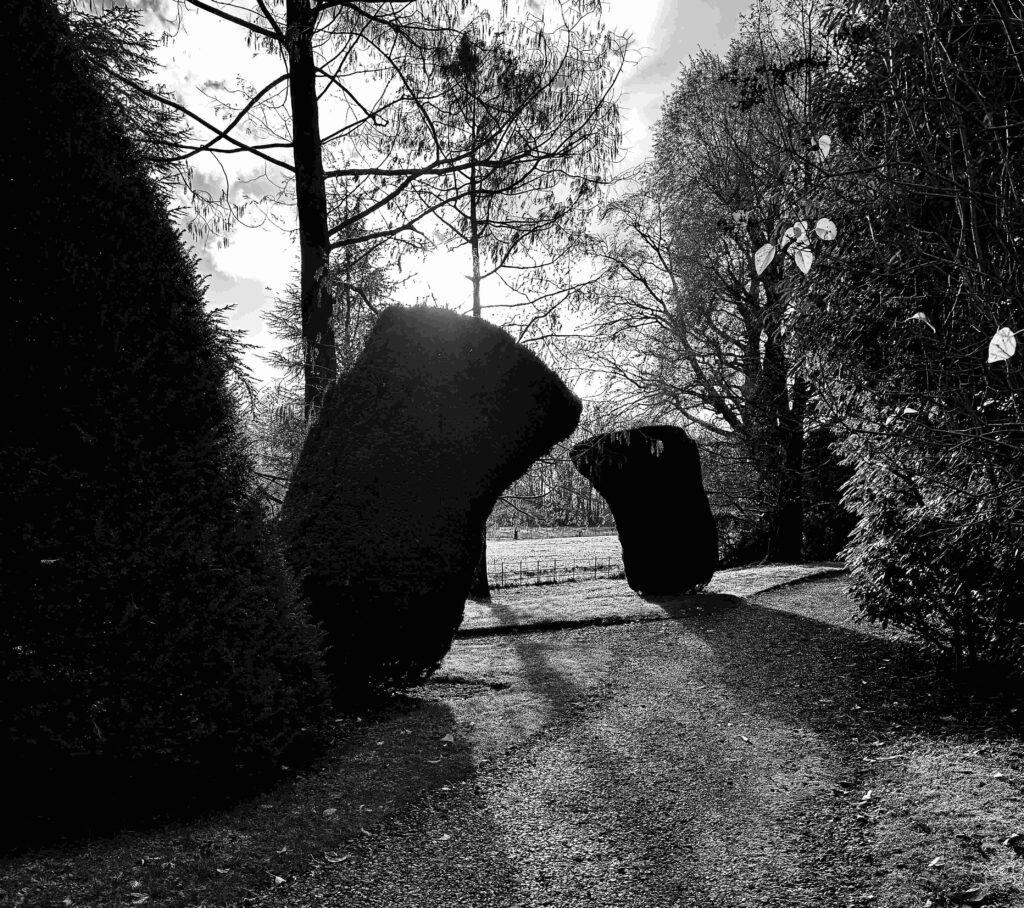The conversation

Walking in a stately garden the other day I suddenly saw these two carefully-trimmed bushes as a pair of animals in conversation with one another, adult to child.
Quote of the Day
”Words ought to be a little wild, for they are the assault of thoughts on the unthinking.”
- John Maynard Keynes
Musical alternative to the morning’s radio news
The Traveling Wilburys | End Of The Line
One of Tim Berners-Lee’s choices on Desert Island Discs.
Long Read of the Day
The Vatican is the oldest computer in the world
Lovely essay by Andrew Brown.
Here’s how it opens…
Francis Spufford once said that Bletchley Park was an attempt to build a computer out of human beings so the credit for this metaphor belongs to him. But it can be generalised to any bureaucracy. They are all attempts to impose an algorithmic order on the messiness of the world, and to extract from it only only those facts which are useful to decision makers.
With that said, it’s clear that the Vatican is the oldest continuously running computer in the world. Now read on …
One way of understanding the Roman Catholic Church is to think of the Vatican as the oldest computer in the world. It is a computer made of human parts rather than electronics, but so are all bureaucracies: just like computers, they take in information, process it according to a set of algorithms, and act on the result.
The Vatican has an operating system that has been running since the days of the Roman Empire. Its major departments are still called “dicasteries”, a term last used in the Roman civil service in about 450 AD.
Like any very long running computer system, the Vatican has problems with legacy code: all that embarrassing stuff about usury and cousin marriage from the Middle Ages, or the more recent “Syllabus of Errors” in which Pope Pius IX in 1864 denounced as heresy the belief that he, or any Pope, can, and ought to, reconcile himself, and come to terms with progress, liberalism and modern civilization,” can no longer be acted on, but can’t be thrown away, either. Instead it is commented out and entirely different code added: this process is known as development.
But changing the code that the system runs on, while it is running, is a notoriously tricky operation…
It is.
What I like about this essay is how it suggests a different perspective on other computer-like ‘machines’ that exist in our world. For years I’ve thought of corporations — especially large ones — as ‘superintelligent machines’ (which is why I think that much of the faux-nervous speculation about what it would be like to live in a world dominated by superintelligent machines is fatuous. We already know the answer to that question: it’s like living in contemporary liberal democracies!)
Charlie Stross, the great sci-fi writer, calls corporations “Slow AIs”. Henry Farrell (Whom God Preserve) writes that since Large Language Models (LLMs) are ‘cultural technologies’ — i.e. information processing machines’ — they belong in the same class as other information-processing machines — like markets (as Hayek thought), bureaucracies and even states. David Runciman, in his book Handover:How We Gave Control of Our Lives to Corporations, States and AIs* makes similar points.
Of course these are all metaphors with the usual upsides and downsides. But they are also tools for thinking about current — and emerging — realities.
Feedback
Ioan Claudiu Todoran was visiting Paris (lucky devil) and read my piece in the November 5 edition about The Monument exhibition at the Fondacion Cartier-Bresson. So he went to see it.
“As someone born in a communist country,” he writes,
Sibylle Bergemann’s The Monument exhibition piqued my interest and I decided to add it to our itinerary, alongside the already planned visits to the Museum of Decorative Arts (for the One Hundred Years of Art Deco exhibition) and Palais de Tokyo.
There were a couple of lenses offered to interpret the exhibition, with the obvious one being as a critique of a slowly collapsing regime. But my preferred one was seeing the photographs (almost) as staged, with often theatrical, comical effects: Marx and Engels missing the upper body, being covered by what looks like garbage bags (but are probably rain coverings), with the structure revealing a wooden framework (with the legs looking thin and weak) and my favorite ones: two workers working at Engels’ feet (tying his shoes, maybe?) and one with adults climbing the monument like joyous children.
This Blog is also available as an email three days a week. If you think that might suit you better, why not subscribe? One email on Mondays, Wednesdays and Fridays delivered to your inbox at 5am UK time. It’s free, and you can always unsubscribe if you conclude your inbox is full enough already!
